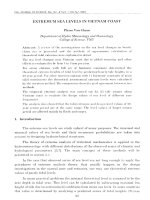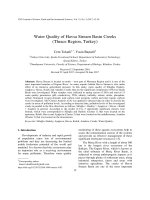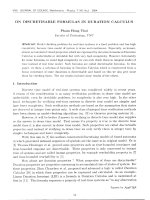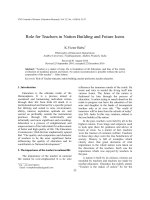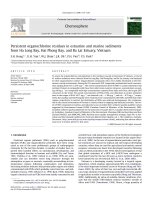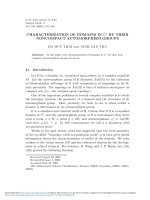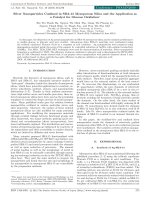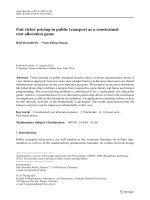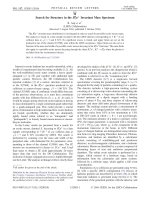DSpace at VNU: Standard quality support in technical equipment repair
Bạn đang xem bản rút gọn của tài liệu. Xem và tải ngay bản đầy đủ của tài liệu tại đây (884.39 KB, 8 trang )
VNU Journal of Science, Mathematics - Physics 27 (2011)
37 -44
Standard quality support in technical equipment repair
A.P. Kastriuk, V.P. Ivanov
Polotsk State University, Republic of Belarus
Received 7 December 2010
Abstract. The necessity for technical equipment repair and its economic effrciency
is
substantiated. The quality of technical equipment repair is assessed on the basis of technological
(manufacturing) criteria that are provided at machinery repair, and on the basis of performance
(consumer) criteria that are displayed at machinery usage. The necessity and means for improving
the quality of technical equipment repair on the basis of the experience
introduction ofthe quality system for rhachinery repair are shown.
of
development and
Key words: repair, quality, criteria, quality system.
The necessity for machinery repair. Limited government reserves of fuel and materials cannot
provide sufficient reproduction of machine paik by means machinery construction and along with its
preservation require development of repair industry, which requires much direct labour and
materialized labour. Machine components fail at different time, therefore the requirement in
machinery repair arises at different operation moments. Repair ensures normative reliability of
machinery during al their working life. Machinery repair allows to use the preserve use value in form
of remaining life of its components. Machinery modernization carried out during repairs, allows to
considerably draw nearer the time of physical deprecation and obsolescence of machinery as well as to
improve its technical level and adjust it to the new requirements of usage. Repair is economically
expedient. About a quarter of repair fund components are not worn out or are worn within permissible
limits and can be reused at the cost of 2-3yo, and about a half of components can be used after
restoration at cost price of 15-30% of new components cost respectively. Components restoration
saves a great number of materials, energy and labour.
The present state of repair industry is characterized by deterioration of quality of repaired
machinery. Only 40-60Yo of machines and 1040% of their component units reach normative postrepair operating time (Pic. 1). Marks in form of circles in diagrams correspond to normative operating
time and quantity of component units out of production.
37
38
A.P. Kastriuk, V.P. Ivanov
/ WU Journal of Science,
y, yo
75
M3-5
5"0
YM l-45lIv
I
{
JJ
-z502
25
0
a
I
4
I
Msthematics - Physics 27 (201l) 37-44
,/
t.t
{
/
'ir^l '.3-24
/
100
150
Z. ruc. rvr
Fig. L Repaired components share 1 of components out of service at accrued operating time L.
Quality criteria are subdivided into technological (manufacturirg) and performance (consumer)
(Table 1.). Criteria of the first group are ensured at machinery repair, they considerably influence
criteria of the second group that are revealed and supported at the use of a machine according to its
intended purpose. At that a number of technological parameters value require stiffening with the aim
of improvement of perfonnance criteria.
.
Table
l
Criteria for technical state of machines and their components
Product
Criteria
Technolosical
Components
Surface purity
Chemical and structural composition of a material
(core and friction surfaces)
Relationship and shape ofsurfaces
Linear and angular dimensions
Roughness (microgeomehy) of surfaces
Progressive motion components weight
Weight distribution with respect to rotation axis
Assemblv units
Walls tightress
Closing dimensions
Assembly efforts and instants
Progressive motion products weight
Weight distribution with respect to rotation axis and
inertia
Performance
Wear resistance
Static capacity
Fatigue resistance
Rigidity
Corrosion resistance
Heat stability
Dwabilitv
Durability
Joints tightness
Aggregates
Closing dimensions
Assembly efforts and instants
Running in of friction surfaces Parameters of
processes (motion, velocity, acceleration, time etc.)
Torques
Joints tishbress
Balance
Operating sound ,
Walls vibration
Temperature of basic parts walls
Consumption and pressure
Corrosion resistance
A.P. Kastriuk, V.P. Ivanov
/ WU
Journal of Science, Mathematics - Physics 27 (201I) 37-44
Adjustment characteristics (allowances,
displacement, efforts, pressure, medium consumption
39
Harmful substances emission
Durability and reliability
etc.)
Machines
Relationship of machine components
Assembly efforts and instants
Composition, width, strength and smoothness
of
lacquer coatings
Tractive values
Braking values
Adjustment characteristics (allowances,
displacement, efforts, pressure, medium consumption
etc.)
Safety in use
Fuel consumption for operating
time unit
Dynamic characteristics
Ride comfort
Controllabilify
Marketable state
Driver's operating conditions
Environmental contaminants
emission
Corrosion resistance
Durabilitv and reliabilitv
Quality assessment. Quality of machines repair can be assessed by the share of technological
criteria (Table) that are within normative limits. In case the share is 60 %o,80 % post-repair resource
with respect to new products can be achieved. At present, according to our estimation, the share of the
criteria which values are within normative limits is 20-25 %.
Quality improvement aspects. In spite of the complexity of the problem of repair quality
for its solution are as follows. As the first step it is necessary to take into
account and analyze all the technological ctiteria with their normative values for componentg
support, the directions
assembly units and aggregates. These criteria determine the unconditional quality level and include
geometrical, structural, and phisyco-chemical values. The second step is to allocate and use the
means and procedures of repair that can ensure the mentioned criteria. It is possible that the existing
at an enterprise techniques will not be enough to ensure the values in a range of parameters. It will be
necessary either to purchase the lacking, as a rule, expensive means or to allocate respective work at
other enterprises on cooperation conditions.
The normative quality level of repaired machines can be obtained by means of development at an
enterprise of a quality system for machinery repair (QS MR) and its introduction into production.
Quality system for machinery repair - variety of workers actions regulated by an enterprise
standards, necessary for obtaining normative quality of repaired machines and its continuous
improvement.
The specified standards of an enterprise determine the objective of QS MR, its functional and
organisational structwe, processes and resources, required for quality control at machinery repair.
The aim of the system is to reach the values of repaired machines quality not less than normative
and exceeding respective values of machines produced by leading repair enterprises of the branch. The
tasks ofthe system is to create conditions for such production output.
Conditions of production implicate that work places must be provided with quality materials,
semi-finished products, and components, that certified fault-free repair means are used, that the
production process is carried out in due order and according to a specified pattern, that the modes of
product treatment conform to requirements of technological processes, that there is properly trained
and certified personnel, and production quality control.
40
A.P. Kqstriuk, V.P. Ivanov
/ WU
Journal of Science, Mathematics - Physics 27 (2011) 37-44
Functional structure of the system is determined by worker's activity and their interaction on
quality assurance support. These functions are subject to the objective of the system and include:
planning, control, management and continuous improvement of production quality. The system
operation is connected with resource consuming and is assessed on the basis of criteria.
Quality planning is consists in defining the requirements for production and working out of
measures for these requirements achievement.
Quality control includes a multitude of actions within managerial control of an enterprise for the
system objective achievement. All workers at an enterprise are involved in the activities for the
objective achievement, but officials of the enterprise bear the responsibility for the general quality
management.
Quality control - types and measures of activity of enduring fulfillment of requirement to
production quality. Such activity provides both for technological processes control, their adjustment,
date acquisition and isolation of causes and removal of causes of unsatisfactory quality.
Quality improvement is a continuous activity of en enterprise workers, aimed at production quality
improvement, and perfecting of components of production and quality system.
Organisational structure is determined by relations and interaction of workers at an enterprise,
their responsibility and authorities. Limits of responsibility for quality and authorities of each worker
with description of cases in which the worker has to interact with other persons are determined by
Regulations on divisions (workshops, departments) and job descriptions.
System for stimu'lation of workcrs at an enterprise responsible for production quality takes into
consideration both responsibility limits of the,personnel for work execution influencing the quality,
and the results of such work.
The modern QS MR is built in accordance with requirements of standards ISO 9000 [1-3]. The
major principles of creation and operation of QS MR are as follows.
Competitiveness of repaired machines, increasing of labour productivity and improvement of
economic indicators of an enterprise due to product market extension and increasing profitability of
production sales are achieved by means of continuous and systematic improvement of technological
processes and organisation of production. Such improvement is favoured by a modem quality concept
[4], that includes:
- availability of a policy in the sphere of quality;
- replacement of a number of suppliers (with respect to every tlpe
of purchased materials, semi-
finished materials and products) for a long-term relations with one supplier;
continuous evolutional quality improvement due to improvement of quality system, resource
base and organisational structure of an enterprise, elimination of quantity indicators;
- elimination of complete control of production quality and introduction of sampling methods;
- introduction of new methods of management of an enterprise and its divisions and assessment of
-
personal characterisfics of employees;
- systematic training and retraining of all the personnel at an enterprise.
Quality policy as a description of the aim and major principles of QS MR is determined by the head
of an enterprise who allocated the responsibility for functioning of quality system components among the
enterprise employees. Each employee performs his own fi.rnctions, which he is responsible for.
Quality policy is implemented at target organisational and technical prograrnmes for assurance and
improvement of production quality, effective for a year of a number of years.
A.P. Kastriuk, V.P. Ivanov
/ WU
Journal of Science, Mathematics - Physics 27 (2011)
37-44
4l
development of QS MR it is considered that the basic requirements to products quality are
established by the customer. Marketing research of consumers' demand and supply are carried out at
an enterprise. The research results are included in specification requirements. The principle in action
is: not to sell the manufactwed products, but to produce what is being sold!
production assurance QS MR operates in interaction with other systems of preproduction and
structural, techndlogical, organisational, supply and sales. This means that QS MR is an integral part
At
of the system of en enterprise management and operates as its component part.
deals with: from
QS MR action is extended to the stages of productive cycle which an enterprise
life.
demahd analysis to its utilization at the end of useful
principle
QS MR contributes to continuous improvement of machinery repair. To implement this
the content of quality irqprovement should be defined, the improvement should be justified,
motivation should be stimulated and personnel should be frained in the area of quality control'
Introduction of QS MR eliminates the featurelessness of machinery being repaired as well as its
components. The system is aimed at prevention of problems, not at overcoming their consequences.
QS MR provides for certification both of personnel and of an enterprise'
QS MR is set out in form of documents that present the system components, their functions and
requirements to them. Form of the system documents is established by each enterprise independently.
The documents are available for users, their requirements are specific and unequivocal. Some
documents are kept by the employees who they are developed for.
All the QS MR components are subject to regular internal and external audit. This is necessary for
reliable functioning of the quality system and the enterprise management certainty in the fact that the
designated aim is being achieved. Audit is carried out in accordance with a schedule developed by the
personnel.
QS MR shall be regularly analyzed and assessed by the enterprise management. The basic
information sources about the system operation are regular reports by heads of plant divisions and
audit reports. A person authorized for quality generalizes the reports and prepares a report to the
enterprise management at least biannually. The report contains the answers to the questions: are the
basic regulations on the quality policy complied with? are the consumers satisfied with production
quality? is the aim of the enterprise in the area of quality being achieved? what is the reputation of the
enterprise on the market? is the current system for detecting and removing the reasons of existing or
potential discrepancies efficient? The report is adjoined by suggestions on quality system
improvement.
Production monitoring is acquisition of data on its state during repairs at the enterprise and
subsequent stages of life cycle outside the enterprise. A repair enterprise draws information about the
quality of repair of its products from the following sources:
- operational inspection of products;
-register ofdefects detected during acceptance tests ofmachines and aggregates;
- list of defects detected during warranty period;
- data from supporting sectors, that use the repaired machines and collect data on,their failures;
- Data on accrued operating time and condition of aggregates and machines for overhaul repair;
- data on post-repair operating time of machines subject to write-off.
42
A.P. Kastriuk, V.P. Ivanov
/ WU
Journql of Science, Mathematics - Physics 27 (2011) 37-44
Product labeling is the procedure of making marks and labels on products being repaired (restored)
for the purpose of their accounting. Machines, aggregates and some components are usually labeled.
Components that have an effect on safety and reliability of repaired aggregates are labeled. The fact of
products labeling is reflected in repair documents on the products. Specifications contain the
information on the way of labeling: code and type of marks, forms of running schedule for a
component and technological passport ofan aggregate or a machine. Labeled products are accounted.
Traceability of products means location of place and time of repairsthat resulted in defective
products output as well as identification of employees who canied out the work and assessed it.
Irabeling and traceability procedures identiff the usage and location of defected products.
Traceability must ensure retrospection of the inflow of repair fund, materials, semi-finished goods, and
spare parts, implementation on technological procedures of repairs as well as determination of
location, conditions and operating time of products.
Concrete defects are defined and removed with the aim of elimination of their recurrence with the
help of corrective actions; feasible defects are eliminated with the help of preventive actions.
Elimination of defects causes is connected with changes in specifications to materials, semifinished goods, and marketable products, technological procedures and orgarrisation standards, storage
and transportation of goods.
Corrective and preventive measures are developed on the basis of all the types of production tests,
testing certificates of procedures discipline, audit results, suggestions on improvement of
technological processes, proceedings of "Quality day", write-off certificates for defective production,
cases ofproduction output according to specialbanctions, detection ofdefects during warranty period"
Enterprise certification is a package plan for defining its potential for machinery repair in
accordance with requirements of normative and repair documents. Certification is subdivided into two
types - planned and inspection. Production is certified within factory and state certification. Separate
workplaces (procedures) are certified, by results of which a decision on the state of production
divisions, then workshops, and finally - the whole of the enterprise.
Production certification includes inspection of repair and technological documentation, knowledge
and capability of emirloyees for assurance of specification requirements, production order at
workplaces, equipment state, accessories (including that of equipment) and measuring means.
At inspection of repair documents adequacy of requirements to production quality is established.
Further it is established if all the requirements of repair documentation ate considered in specifications
and ensured by them.
Skill grade of a worker must not be lower than the grade of the job carried out. Knowledge within
qualification requirements, as well as knowledge of the structure of the product being repaired,
procedures of its repair, possible causes of defects and measures for their prevention is checked. A
worker must show the skill to take measurements indicated in specifications.
At equipment control the presence of fixed-schedule repairs and their implementation is checked.
Selectively technological precision of machines according to developed techniques using available
accessories is checked. Employees at auxiliary production must show their skills related to equipment
inspection for its technological precision and repairs. Inspectors pay attention to lubrication of
machinery and its filling with lubricant coolants.
A.P. Kastriuk, V.P. Ivanov
/ WU
Journal of Science, Mathematics - Physics 27 (2011)
37-44
43
accessories inspection fulfillment of the schedule of control of technological
precision, availability of techniques and necessary organisation standards for the contol is checked.
Selectively, some samples of accessories are inspected.
Measuring tools shall be inspected in accordance with the schedule. There should be no
measurement tools on working places that are not indicated in specifications or with expired term of
At production
inspection.
And, finally, randomly select aggregates or machines accepted by Quality Control Department at
warehouse. The product's control values are measured and compared with their normative
parameters. In such a case partial dismantling of the product is possible.
Enterprise certific ation pre supposes periodic production testing.
Requirements to the quality system being developed as well as its structure are specified in the
Standard ISO 9001. Model list of an enterprise standards forming QS MR is outlined in Table 2.
Table 2. Enterprise standards in the sphere of quality
Standards grouD
Management responsibility
Oualitv plannins
Contract analysis
Project management
Documents management
Standards name
General responsibility of management
Manasement resoonsibilitv in the sohere of oualitv.
Nomenclature and procedure of quality plannine
Marketing activity organisation at an enterprise
Procedure of contract elaboration and its execution
Requirement specification development and endorsement
Production development and output procedure.
Proiect management. Field supervision.
Accounting, keeping, circulation of design and technological documents
Quality system documents management
Purchases
Marketable products
manasement
Processes control
Supplies of machinery and machinery and its procedure
Management of products supplied to consumer
Identification and traceabilitv of products
Development and implementation of logistic measures
Preproduction planning
Production scheduling
Day-to-day production management
Working out, ratification and intoduction of technological documents
Procedures discipline conkol
Development, production and testing of technique means Technological
service and maintenance of technological equipment
Procedure o equipment inspection for technological precision
Technological accessories inspection for technological precision
Special processes management procedure
Procedure for factorv <Oualitv Dav>
Tests and control
Management of control,
measurement and testing
eouipment
Control and tests status
Incoming inspection of materials, semi-finished goods and products
Product contol in the course ofproduction process
Finished products tests
Metrological support of production
Accounting, inspection, storage and maintenance of measruement means
Control and tests status
44
A.P. Kastriuk, I/.P. Ivanov
/ WU
Journal of Science, Mathematics - Physics 27 (2011) i7-44
Undue products management
Undue products management
Corrective and preventive actions
Development, implementation and assessment of corrective measures
Handling operations, storage,
packing, preservation and supply
ofproducts
Procedure
assessment
Management of quality data
resistration
Internal oualitv audit
Trainine of personnel
Production service
Statistical methods
ofinflow acceptance, storage, and on-site relocation of
materials, semi-finished goods and spare parts
Acceptance procedure for finished products to a warehouse, its storage,
accounting and shipping.
In-plant containers ciculation procedure
Management of quality data registation
Intemal quality audit procedure
Trainins and professional development of employees
Warranty service
Examination of customers' claims and reclamations
Statistical methods in quali8 control
Conclusions. Normative quality in machinery repair will be achieved at such organisation when
the values of all the quality parameters of components, assembly units, aggregates and machines are
within specified limits. Such organisation is created by means of development and introduction of
quality system of machinery repair on the basis of standards ISO 9001.
References
[1] ISO 9000-1, General quality
management and standards for quality,rssurance,
P.
l: Guidelines on selection and
application,1994.
[2]
[3]
ISO 9004-1, General quality management and elements of quality system, P. l: Guidelines,1991.
ISO 9000-2, General quality management and standards for quality assurance, P. 2: Guidelines on application ISO 900 I ,
ISO 9002 and ISO 9003,1993.
[4]
Deming W. Ed. Qality, Prodyctivity and Competitive Position (Cambridg, Mass, M.I. Center for Advanced Engineering
Study, 1982).
